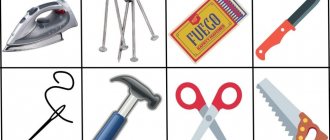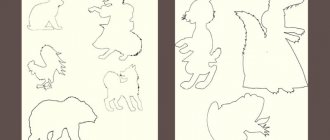Card index of didactic design games for children of senior preschool age
Maria Oleynik
Card index of didactic design games for children of senior preschool age
Card index of didactic design games for the senior group.
Educator: Oleynik Maria Alexandrovna
Construction
«We construct from sticks»
Purpose of the game: development of children's .
Material: sticks of different lengths in three sizes, cards depicting simple pictures .
Progress of the game. Children are given sticks of different lengths and asked to divide them into three parts according to size. Then they give pictures (real images of simple-shaped objects: a flag, a car, a boat with a sail, a wheelbarrow, a flower, a vase, etc.) and ask them to lay out the image of these objects with chopsticks.
"Remember what it's like"
Purpose of the game: to train children in naming geometric shapes.
Material: cards with images of geometric shapes.
Progress of the game. Children are offered cards with pictures of construction parts. The teacher asks to name the detail and remember objects that are similar to it, while justifying why he points out these objects.
"Count and design "
Purpose of the game: Development of logical thinking in preschoolers .
Material: Geometric robot cards
Progress of the game. Children are shown a drawing depicting robots made from geometric shapes. The teacher offers to count the robotic men and asks how many robotic dogs there are. Asks you to choose any robot, tell what shapes it is made of, how many identical shapes and parts went into it. Then the children are given geometric shapes and asked to put their favorite images out of them.
"Arrange your room"
Purpose of the game: development of logical thinking in preschoolers .
Material: sheet of paper (35*45cm, construction set, planar geometric shapes.
Progress of the game. The teacher offers the children a sheet of paper (35*45 cm)
and says that this is the floor of a doll’s room, asks to build it with bricks (the walls of the room, leaving gaps for the window and door. After the children do this, he takes out a sheet of paper and puts it next to the built room. Then he takes out geometric shapes and offers to lay them out on paper, selecting pieces of furniture that are similar in shape
(a square is a stool, a rectangle is a bed, etc.)
. The teacher examines the resulting diagram with
the preschoolers and asks them to arrange the “furniture” according to it in a room lined with bricks. At the end of the work, the children compare image with a building.
“Relationship of geometric bodies and figures”
Purpose of the game: to teach children to correlate images of geometric shapes and building parts of a construction set . Material: Cards with images of geometric shapes, construction set.
Progress of the game. Preschoolers are asked to look at images of geometric bodies, and then at the geometric shapes shown below. The teacher asks to find the building parts shown on the card and show those sides that have the shape of the geometric shapes shown under the card . The task becomes more complicated if children are asked to correlate geometric shapes and bodies without using construction parts.
“Let's build a tower for the princess”
“Putting on the details”
Purpose of the game: development of logical thinking in preschoolers .
Material: diagram cards , construction parts.
Progress of the game. Preschoolers are given two cards : on one, in the form of a diagram, various towers are depicted, on the other, construction parts that should be selected to solve this problem. The goal of the task: to lay the parts in the outline so that they come into contact with the surface of the sheet of one of the faces. In the process of solving the task, the teacher clarifies what parts the child uses, what color, what shape of edges this or that part has, how many edges the part has, how many parts went into assembling the image. The teacher brings a princess doll to the group, sits it on a chair and tells it: “Princess, your house will be built soon. We need to choose a good place. I'll call the builders. Who will build a house for the princess? Lena and Lisa, do you know where the construction site will be? Then find us a suitable place where there will be a home for the princess. (The girls find a place for a house)
.
Now we need building materials. Gena and Sasha, help us, please choose everything you need for construction. What do we need? (children name materials: bricks, boards, stones, sand.)
Children, you
will be builders . Build a good house, like a tower.” The children, together with the teacher, build a tower using a building set and available materials. At the end of the game, the teacher shows the new house to the princess and says: “This is your new house, a tower. Are you satisfied, princess? Our builders did a good !
They can build other beautiful houses" "Build according to the model"
Purpose of the game: to teach children to build structures using a finished model .
Material: three-dimensional models, construction kit . Progress of the game. structures from building materials and cover them with paper or fabric to create three-dimensional models. a general idea of the design , but you have to guess what parts it is assembled from. Invite the children to build buildings using these models. (Children of the preparatory group construct structures based on the depicted undivided three-dimensional models .)
"Create a diagram"
Purpose of the game: development of logical thinking in preschoolers .
Materials: planar geometric shapes, felt-tip pens, sheets of paper, contour diagrams, construction kits.
Progress of the game. Invite the children to lay out various simple images of buildings on paper from pre-cut cardboard geometric shapes (front view, then trace all the shapes with felt-tip pens - you will get diagrams. They can be used as aids for planar modeling (Children in the preparatory group are asked to create contour diagrams, tracing not every geometric figure, but the general outline of the figures combined in the model.) Then the children are tasked with dissecting these diagrams, concretizing them (coloring them)
.Complication: it is proposed to build buildings according to contour diagrams.
"Scheme Modeling"
Purpose of the game: Teaching children how to model according to a diagram. Material: cards depicting geometric shapes and diagrams of structures, construction details.
Progress of the game. Children are offered two maps : one depicts geometric shapes, the other shows diagrams of structures. The task is given - to select the necessary figures according to the diagram and begin modeling. The task can be complicated by offering construction parts instead of geometric shapes.
"Make it up from sticks"
Purpose of the game: to train children in making geometric shapes from counting sticks.
Material: counting sticks.
Progress of the game: Preschoolers are trained in making geometric shapes from counting sticks.
1. “Make a figure from three (four, five, six)
sticks."
2. “Make two equal triangles from five sticks
.
"Find the error"
Purpose of the game: development of logical thinking in children . Material: cards with images of geometric shapes.
Progress of the game. Children are offered a card , it depicts geometric figures, inside of which there is a geometric body. Moreover, one of the faces of the geometric body must have the shape of the figure on which the body is drawn. You need to find an error in the image. 3. “Build three squares from ten sticks (by attaching one figure to another)
».
"Switching Places"
,
“What has changed”
children’s logical thinking . Material: construction parts.
Progress of the game. Construction parts are placed in front of the child. They ask you to remember how many there are and how much they cost. Then they are asked to turn away and remove any part (they install the parts in a different position on the plane of the table, change their places, add new ones). Then the preschooler notes what has changed.
Purpose of the game: development of memory and logical thinking of children .
Materials: sheets of paper, construction parts, felt-tip pens.
Progress of the game. Two people are playing. Children are seated with their backs to each other and asked to place small construction parts on a sheet of paper, placed tightly to each other so that each part is in contact with the surface of the sheet with one of the faces, and outline the resulting figure with a felt-tip pen. Then remove the parts from the sheet, swap places and reinstall them on the sheet of paper exactly inside the outline. The more details are offered, the more difficult the task.
"Robots"
Purpose of the game: development of children's . Material: cards with images of robots.
Progress of the game. The map shows robots assembled from building parts. Children are asked to answer questions. 1. “How many robots are shown.” 2. “Find two robots assembled from parts of the same shape”
. 3.
“Show me which robot has a part that the others don’t have”
.
"Cut and fold"
Purpose of the game: development of children's .
Material: thick paper, scissors.
Progress of the game. Children are asked to cut out any geometric shape from thick paper, cut it into several pieces of different sizes, and then fold it again. Children are given the opportunity to establish a pattern: the more parts you get, the more difficult it is to fold the figure, but you can create more new images. The task can be complicated by inviting the children to exchange cut out figures. 4. “Which robots can be built from building parts, and which cannot?”
"Modeling"
children's imagination and logical thinking . Material: planar geometric shapes, sheets of paper, pencils.
Progress of the game. Invite children to model, using paper geometric shapes, structures they have drawn or made using the appliqué technique (palaces, cathedrals)
.
Then make diagrams and use them to construct these objects .
Classification methodology
There are several criteria for classifying games and dividing them into groups. This makes it possible to choose an activity that best suits specific pedagogical tasks.
Self-study
Selection of materials for classes
Depending on the content, classes are divided into various types aimed at improving a particular skill in children. Accordingly, various materials are used, such as:
- toys;
- Pictures;
- various household items;
- board games that you can print out yourself.
Lesson on FEMP and parental consultations in preparatory groups
The role of the teacher in organizing games
Based on the type of lesson, level of training of the group and their independence, the teacher’s influence on the process can be either primary, for example, as a leader, or secondary, when he observes from the side and only if necessary directs actions in the right direction.
Conducting didactic classes
Pedagogical classes for children in the senior group of kindergarten involve techniques that can be divided into three categories.
- Verbal. The priority goal of developing the speech center in children of the older group is to form a comprehensive vocabulary and a set of non-verbal skills.
- Visual. Abstract thinking is poorly developed in children of this age. They have a leading visual-figurative model of perception. The teacher’s task is to combine these methods of perceiving information by demonstrating visual images.
- Practical. It is important that during the lesson the child creatively embodies his vision of the game in various forms of artistic implementation: draws the object of the game; I made an applique (this method fits in very well after playing with numbers); made a craft or molded something out of snow if the activity takes place outside in winter.
Didactic classes as a topic for teacher self-education
Throughout his professional career, a preschool teacher constantly improves himself, practices and improves his speech and methods of interaction with children and their parents. And didactic classes play a significant role in this, facilitating the learning process for young students. Self-education on this topic is possible by reading relevant literature.
Indicators of the development of a child’s creative thinking
It is no secret that the most successful form of learning for preschoolers is a didactic game. This can only be achieved with proper design, planning and presentation of the material by the teacher, so a very important factor is the continuous self-development of the teacher.




